To: 05/03/2019 17:00
Aerial archaeology in Greece is still an exceptional and uncommon practice. Archaeological or historical projects making use of historical or modern aerial photographs can be counted in half dozen so far. The project “Crete from Above” brings prominently the bird eye view in the complex and pluri-stratified Cretan archaeological and historical context. The approach aims at identifying and mapping abandoned and forgotten historical and modern artefacts on the mountainous landscape of the major Greek island. The project originates from the consideration that the space which surrounds us and with which we continuously interact, is not a static entity. It is the result of the complex relations and influences of humans (and their cultures), animals and landscapes. Material and tangible results of such interactions (which often involve many more variables than the above outlined) are normally reshaped, repurposed, obliterated, damaged or endangered in view of the “development” of certain areas. However, sometimes, past standing structures become iconic elements of the landscape of which they are part, in a certain spontaneous monumentalisation process, as almost fossil or fossilized built landscapes. Main goal of the project is therefore to “tag” abandoned and collapsing artifact with archaeological and historical facts, promoting at once the involvement of local communities and (oftentimes) contemporary users of such artefacts (or what remains of them).
The paper will present “views” of the Cretan mountainous landscape through historical and modern aerial photography, highlighting the difficulties of working in such a challenging context and the ongoing activities for community engagement in an attractive and expanding touristic destination.

Prof. Xenophon Zotos, a collaborating Faculty member of our Institute has been selected along with 143 reviewers thoughout the world for their outstanding contribution to assessing manuscripts in the APS journals. Each year the American Physical Society (APS) chooses to acknowledge the contribution of their reveiwers in the OUtstanding referree program that was intitiated in 2008. The highly selective Outstanding Referee program annually recognizes about 150 of the roughly 71,000 currently active referees. At the start of the program, in 2008 and 2009, larger groups were selected by our Editors for the Outstanding Referee designation, in order to "catch up" and recognize referees who had already served for many years. Like Fellowship in the APS, this is a lifetime award. In this year, 2019, 143 Outstanding Referees were selected. For more details please read the original announcement from Amerian Physical Society
To: 28/02/2019 18:00
This presentation will focus on the application of ultrafast photonic processes for novel materials synthesis, as well as for the development of novel photonic techniques to probe at the nanoscale, which are issues of great interest in current materials science and engineering research [Adv. Mat. 29, 1700335 (2017)].
In particular, Nature inspires us in tailoring unique surface properties based on synergetic effects of chemical composition and multiscale surface morphology. We show that highly controllable, biomimetic structures, exhibiting multifunctional water repellent, anti-reflection, friction reduction and photoresponsive properties can be directly written on metallic and dielectric surfaces upon processing with femtosecond laser beams of tailored polarization [Adv. Mat. 20, 4049 (2008) ; Biomicrofluidics 5, 013411 (2011)]. It is shown that such biomimetic laser structuring is a versatile approach to tune neuronal cell adhesion, proliferation and orientation and can be promising for biomaterial scaffolds for neural tissue regeneration [Biomaterials 67, 115-128 (2015)].
The second part of the presentation will focus on the application of advanced ultrafast laser based techniques for the synthesis and diagnostics of materials and components in photovoltaic, chemical sensing and energy storage systems. Specifically, the pulsed laser assisted fabrication of transparent graphene electrodes and interlayers for photovoltaic devices, is demonstrated [Adv. Func. Materials 25, 2213 (2015)]. Furthermore, we present a fast, non-destructive and roll-to-roll compatible photochemical method for the doping of graphene [Nanoscale 6, 6925-6931(2014)] and transition metal dichalcogenide (TMD) crystals [2D Materials 6, 015003 (2018)]. Finally we present our recent advances in the synthesis [Nanoscale 9, 18202 (2017)] and femtosecond laser spectroscopic diagnostics of perovskite and TMD nanocrystals. Application in sensors and energy storage systems [Nanoscale 2018, DOI: 10.1039/C8NR10009H] are demonstrated and discussed.


